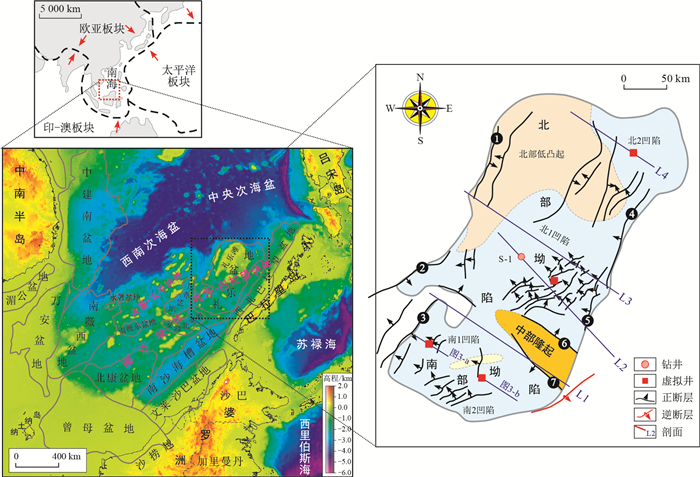Tectonic evolution and depositional response in southern continental marginal basins of South China Sea during period of rift-drift-foreland: A case study from the Liyue Basin
-
摘要: 通过礼乐盆地构造-地层-沉积分析,查明了其构造演化及沉积充填特征,揭示了其与南海扩张事件的成因联系,为南海边缘海演化研究提供了参考。研究结果表明:礼乐盆地新生代构造-沉积演化经历了3个差异显著的阶段,即古新世-早渐新世陆缘裂陷-滨浅海碎屑岩沉积阶段、晚渐新世-早中新世裂离漂移-浅海碳酸盐岩沉积阶段、中中新世以来周缘前陆挠曲沉降-区域差异沉积阶段。古新世-早渐新世,古南海向东南俯冲,华南古陆陆缘因水平引张力作用发生被动裂陷,形成礼乐盆地;此时以滨浅海环境为主,受碎屑物源供给控制,在盆地西北部发育一系列规模相对较大的辫状河三角洲,礼乐盆地东部、南部邻近古南海,仅在孤立隆起边缘发育规模较小的扇三角洲。晚渐新世-早中新世,古南海持续俯冲,新南海扩张,礼乐-巴拉望地块裂离华南古陆,向南漂移,盆地沉降缓慢,断层活动弱;此时以浅海-半深海环境为主,碎屑物源匮乏,盆地北部发育大型碳酸盐岩台地和生物礁,南部总体为半深海环境。中中新世以来,新南海扩张停止,礼乐-巴拉望地块向菲律宾岛弧俯冲碰撞,礼乐盆地进入周缘前陆期,以非对称挠曲沉降为特点,水深增大,断层活动增强;此时以半深海-浅海为主,盆地北部总体以碳酸盐岩台地和生物礁为特色,盆地南部局部发育深水重力流沉积。礼乐盆地构造-沉积演化与古南海俯冲-消亡、新南海扩张-关闭过程密切相关。Abstract: Based on the analysis of tectonics-stratigraphy-sedimentology in Liyue Basin, this paper finds out the characteristics of tectonic evolution and sedimentary fillings, reveals the genetic relationship between the basin evolution and the spreading of the South China Sea (SCS), and provides the reference for the study on the marginal sea evolution of the SCS.The Cenozoic tectonic-sedimentary evolution of the Liyue Basin could be divided into three distinct stages: the first stage characterized by continental marginal rifting and littoral-neritic clastic sedimentation from Paleocene to Early Oligocene, the second stage characterized by detaching-drifting and neritic carbonate sedimentation from Late Oligocene to Early Miocene, and the third stage featured with peripheral foreland flexure subsidence and regional differential sedimentation since Middle Miocene.In the first stage from Paleocene to Early Oligocene, the southeastward subduction of the Proto-South China Sea (PSCS) resulted in the passive rifting of the ancient South China Plate under the action of horizontal extension, and then the formation of the Liyue Rifting Basin.During this period dominated by the littoral-neritic depositional environment from Paleocene to Early Oligocene, controlled by detrital sediments supply and the PSCS action, a series of relatively large-scale braided river deltas developed in the northwestern basin, however, few small-scale fan deltas developed on the edge of the isolated uplifts in the eastern and southern basin adjacent to the PSCS.In the second stage from Late Oligocene to Early Miocene, accompanying with the PSCS continuous subduciton and the SCS initialization and spreading, the Liyue Basin located on the Liyue-Balawan Plate detached from the South China ancient continent, and then southwards drifted with slow subsidence and weak faulting.During this period dominated by the neritic- bathyal depositional environment from Late Oligocene-Early Miocene, due to the scarcely detrital sediment supply, large-scale carbonate platforms and reefs developed in the northern basin, while the bathyal environment was generally founded in the south.In the third stage since Middle Miocene, the process that the SCS spreading had being ceased and the Liyue-Balawan block was subducting towards Philippine island arc, led to the beginning of the evolution of the foreland basin in the Liyue Basin, characterized by asymmetric flexure subsidence, increasing water depth, and enhanced fault activity.During this period dominated by the bathyal- neritic depositional environment, it is the predominant feature that the carbonate platforms and reefs and deepwater gravity flow deposits have respectively being developed in the north and partial south of the Liyue Basin.It could be concluded that the tectonic-sedimentary evolution in Liyue Basin was closely related to the subduction-extinction of the PSCS and the spreading-closure of the SCS.
-
Key words:
- rift /
- drift /
- foreland /
- Liyue Basin /
- South China Sea(SCS)
-
图 4 礼乐盆地主要的构造-地层格架剖面(剖面位置见图 1)
Figure 4. Main profiles showing structural-stratigraphic frameworks in Liyue Basin
图 5 礼乐盆地主要构造单元沉降特征(虚拟井位置见图 1)
1.E3y3; 2.E2y2; 3.E2y1; 4.E3zh2; 5.E3zh1; 6.E3r-N1x; 7.N1h; 8.N1sh; 9.N2-Q
Figure 5. Subsidence characteristics of main structural units in Liyue Basin
图 6 礼乐盆地主要断层不同时期活动特征(断层位置及编号见图 1)
Figure 6. Vertical displacement characteristics of main faults at different periods in Liyue Basin
-
[1] 汪品先. 追踪边缘海的生命史: "南海深部计划"的科学目标[J]. 科学通报, 2012, 57(20): 1807-1826. https://www.cnki.com.cn/Article/CJFDTOTAL-KXTB201220002.htm [2] 刘昭蜀. 南海地质构造与油气资源[J]. 第四纪研究, 2000, 20(1): 69-77. doi: 10.3321/j.issn:1001-7410.2000.01.012 [3] Xia K, Huang C, Jiang S, et al. Comparison of the tectonics and geophysics of the major structural belts between the northern and southern continental margins of the South China Sea[J/OL]. Tectonophysics, 1994, 235(1/2): 99-116. doi: 10.1016/0040-1951(94)90019-1. [4] 周蒂, 陈汉宗, 吴世敏, 等. 南海的右行陆缘裂解成因[J]. 地质学报, 2002, 76(2): 180-190. https://www.cnki.com.cn/Article/CJFDTOTAL-DZXE200202005.htm [5] Metcalfe I. Tectonic framework and Phanerozoic evolution of Sundaland[J/OL]. Gondwana Res., 2011, 19(1): 3-21. doi: 10.106/j.gr.2010.02.016. [6] 李家彪, 丁巍伟, 高金耀, 等. 南海新生代海底扩张的构造演化模式: 来自高分辨率地球物理数据的新认识[J]. 地球物理学报, 2011, 54(12): 3004-3015. doi: 10.3969/j.issn.0001-5733.2011.12.003 [7] 龚再升, 李思田. 南海北部大陆边缘盆地分析与油气聚集[M]. 北京: 科学出版社, 1997. [8] 朱伟林. 南海北部大陆边缘盆地天然气地质[M]. 北京: 石油工业出版社, 2007. [9] Hutchison C S. Marginal basin evolution: The southern South China Sea[J]. Marine and Petroleum Geology, 2004, 21: 1129-1148. doi: 10.1016/j.marpetgeo.2004.07.002 [10] Hayes D E, Nissen S S. The South China Sea margins: Implication for rifting contrasts[J]. Earth and Planetary Science Letters, 2005, 237: 601-616. doi: 10.1016/j.epsl.2005.06.017 [11] Cullen A, Reemst P, Henstra G, et al. Rifting of the South China Sea: New perspectives[J]. Petroleum Geoscience, 2010, 16: 273-282. doi: 10.1144/1354-079309-908 [12] 解习农, 张成, 任建业, 等. 南海南北大陆边缘盆地构造演化差异性对油气成藏条件控制[J]. 地球物理学报, 2011, 54(12): 3280-3291. doi: 10.3969/j.issn.0001-5733.2011.12.026 [13] 解习农, 任建业, 王振峰, 等. 南海大陆边缘盆地构造演化差异性及其与南海扩张耦合关系[J]. 地学前缘, 2015, 22(1): 77-87. https://www.cnki.com.cn/Article/CJFDTOTAL-DXQY201501009.htm [14] 李三忠, 索艳慧, 刘鑫, 等. 南海的盆地群与盆地动力学[J]. 海洋地质与第四纪地质, 2012, 32(6): 55-78. https://www.cnki.com.cn/Article/CJFDTOTAL-HYDZ201206010.htm [15] 雷超, 任建业, 张静. 南海构造变形分区及成盆过程[J]. 地球科学: 中国地质大学学报, 2015, 40(4): 744-762. https://www.cnki.com.cn/Article/CJFDTOTAL-DQKX201504017.htm [16] 张建新, 范彩伟, 谭建财, 等. 莺歌海盆地中新世沉积体系演化特征及勘探意义[J]. 地质科技情报, 2019, 38(6): 51-59. https://www.cnki.com.cn/Article/CJFDTOTAL-DZKQ201906008.htm [17] 刘培, 张向涛, 杜家元, 等. 低地温断陷构造-热演化过程及其石油地质意义: 以珠江口盆地西江主洼为例[J]. 地质科技情报, 2018, 37(2): 149-156. https://www.cnki.com.cn/Article/CJFDTOTAL-DZKQ201802021.htm [18] 谢玉洪. 莺琼盆地区中央峡谷源头沉积特征及油气勘探前景[J]. 地质科技通报, 2020, 39(5): 69-78. http://dzkjqb.cug.edu.cn/CN/abstract/abstract10052.shtml [19] 叶加仁, 赵牛斌, 杨宝林, 等. 涠西南凹陷流沙港组烃源岩生产力及发育模式[J]. 地质科技通报, 2020, 39(1): 105-113. http://dzkjqb.cug.edu.cn/CN/abstract/abstract9931.shtml [20] 任建业, 雷超. 莺歌海-琼东南盆地构造-地层格架及南海动力变形分区[J]. 地球物理学报, 2011, 54(12): 3303-3314. doi: 10.3969/j.issn.0001-5733.2011.12.028 [21] 任建业, 庞雄, 雷超, 等. 被动陆缘洋陆转换带和岩石圈伸展破裂过程分析及其对南海陆缘深水盆地研究的启示[J]. 地学前缘, 2015, 22(1): 102-114. https://www.cnki.com.cn/Article/CJFDTOTAL-DXQY201501011.htm [22] Savva D, Pubellier M, Franke D, et al. Different expressions of rifting on the South China Sea margins[J]. Marine and Petroleum Geology, 2014, 58: 579-598. doi: 10.1016/j.marpetgeo.2014.05.023 [23] 赵宏超, 朱筱敏, 葛家旺, 等. 洋陆转换带类型特征和形成机理及其在南海北部的表现特征[J]. 地质科技情报, 2018, 37(4): 51-60. https://www.cnki.com.cn/Article/CJFDTOTAL-DZKQ201804007.htm [24] 冯旭亮, 刘斌. 南薇西盆地重磁场特征及油气资源远景[J]. 地质力学学报, 2019, 25(1): 105-114. https://www.cnki.com.cn/Article/CJFDTOTAL-DZLX201901043.htm [25] 张功成, 王璞君, 吴景富, 等. 边缘海构造旋回: 南海演化的新模式[J]. 地学前缘, 2015, 22(3): 27-37. https://www.cnki.com.cn/Article/CJFDTOTAL-DXQY201503003.htm [26] 孙龙涛, 孙珍, 詹文欢, 等. 南沙海域礼乐盆地油气资源潜力[J]. 地球科学: 中国地质大学学报, 2010, 35(1): 137-145. https://www.cnki.com.cn/Article/CJFDTOTAL-DQKX201001017.htm [27] 吴时国, 赵学燕, 董冬冬, 等. 南沙海区礼乐盆地碳酸盐台地地震响应及发育演化[J]. 地球科学: 中国地质大学学报, 2011, 36(5): 807-814. https://www.cnki.com.cn/Article/CJFDTOTAL-DQKX201105007.htm [28] 李鹏春, 赵中贤, 张翠梅, 等. 南沙海域礼乐盆地沉积过程和演化[J]. 地球科学: 中国地质大学学报, 2011, 36(5): 837-844. https://www.cnki.com.cn/Article/CJFDTOTAL-DQKX201105011.htm [29] 丁巍伟, 李家彪, 黎明碧. 南海南部陆缘礼乐盆地新生代的构造-沉积特征及伸展机制: 来自NH973-2多道地震测线的证据[J]. 地球科学: 中国地质大学学报, 2011, 36(5): 895-904. https://www.cnki.com.cn/Article/CJFDTOTAL-DQKX201105018.htm [30] Yao Y J, Liu H L, Yang C P, et al. Characteristics and evolution of Cenozoic sediments in the Liyue Basin, SE South China Sea[J]. Journal of Asian Earth Sciences, 2012, 60: 114-129. doi: 10.1016/j.jseaes.2012.08.003 [31] Steuer S, Franke D, Meresse F, et al. Oligocene - Miocene carbonates and their role for constraining the rifting and collision history of the Dangerous Grounds, South China Sea[J]. Marine and Petroleum Geology, 2014, 58: 644-657. doi: 10.1016/j.marpetgeo.2013.12.010 [32] Tang X, Chen L, Hu S, et al. Tectono-thermal evolution of the Reed Bank Basin, southern South China Sea[J]. Journal of Asian Earth Sciences, 2014, 96: 344-352. doi: 10.1016/j.jseaes.2014.09.030 [33] Ding W, Li J, Dong C. Oligocene-Miocene carbonates in the Reed Bank area, South China Sea, and their tectono-sedimentary evolution[J]. Marine Geophysical Research, 2015, 36: 149-165. doi: 10.1007/s11001-014-9237-5 [34] 王一博, 张功成, 赵志刚, 等. 南海边缘海构造旋回对沉积充填的控制: 以礼乐盆地新生代沉积为例[J]. 石油学报, 2016, 37(4): 474-482. https://www.cnki.com.cn/Article/CJFDTOTAL-SYXB201604006.htm [35] 刘海龄, 阎贫, 赵俊峰, 等. 南海东南部海域地质构造及其油气资源效应研究[M]. 北京: 科学出版社, 2017: 1-233. [36] 吴智平, 刘雨晴, 张杰, 等. 中国南海礼乐盆地新生代断裂体系的发育与演化[J]. 地学前缘, 2018, 25(2): 221-231. https://www.cnki.com.cn/Article/CJFDTOTAL-DXQY201802029.htm [37] 张亚震, 李俊良, 裴健翔, 等. 礼乐盆地深水区新生代生物礁的发育条件与地震特征[J]. 海洋地质与第四纪地质, 2018, 38(6): 108-117. https://www.cnki.com.cn/Article/CJFDTOTAL-HYDZ201806011.htm [38] Du X, Lu Y, Li X, et al. Development and controlling factors of Upper Oligocene-Lower Miocene carbonate platforms and reefs in the Liyue Basin, South China Sea[J]. Geological Journal, 2018, 54: 3272-3285. doi: 10.1002/gj.3324 [39] Tong D, Ren J, Liao Y, et al. Cenozoic tectonic events and their implications for constraining the structure and stratigraphic styles from rifting to collision at the southeastern margin of the South China Sea[J/OL]. Marine Geophysical Research, 2019. doi: org/10.1007/s11001-018-09376-0. [40] 兰蕾. 南海南部盆地烃源岩特征及其对含油气性的影响[J]. 地质科技情报, 2019, 38(4): 23-29. https://www.cnki.com.cn/Article/CJFDTOTAL-DZKQ201904004.htm [41] 张莉, 李文成, 曾祥辉. 礼乐盆地地层发育特征及其与油气的关系[J]. 石油实验地质, 2003, 25(5): 469-480. doi: 10.3969/j.issn.1001-6112.2003.05.009 [42] Madon M, Kim C L, Wong R. The structure and stratigraphy of deepwater Sarawak, Malaysia: Implications for tectonic evolution[J]. Journal of Asian Earth Science, 2013, 76: 312-333. doi: 10.1016/j.jseaes.2013.04.040 [43] 刘雨晴, 吴智平, 张杰, 等. 南海南部礼乐盆地结构演化及其对区域地质背景的响应[J]. 地质学报, 2018, 92(9): 1766-1779. doi: 10.3969/j.issn.0001-5717.2018.09.002 [44] Hall R, van Hattum M W A, Spakman W. Impact of India-Asia collision on SE Asia: The record in Borneo[J]. Tectonophysics, 2008, 451: 366-389. doi: 10.1016/j.tecto.2007.11.058 [45] 杨树春, 仝志刚, 贺清, 等. 潮汕凹陷中生界生烃历史及火成岩侵入影响分析: 以LF35-1-1井为例[J]. 中国海上油气, 2008, 20(3): 152-156. doi: 10.3969/j.issn.1673-1506.2008.03.003 [46] Koppers A A P, Staudigel H, Duncan R A. High-resolution 40Ar/39Ar dating of the oldest oceanic basement basalts in the western Pacific Basin[J]. Geochemistry, Geophysics, Geosystems, 2003, 4(11): 1-20. http://www.researchgate.net/publication/285884229_Highresolution_40Ar39Ar_dating_of_the_oldest_oceanic_basement_basalts_in_the_western_Pacific_basin_Hot_spots_or_extensional_volcanism [47] Mazur S, Green C, Stewart M G, et al. Displacement along the Red River fault constrained by extension estimates and plate reconstructions[J/OL]. Tectonics, 2012, 31, TC5008. doi: 10.1029/2012TC003174. [48] Briais A, Patriat P, Trapponier P. Updated interpretation of magnetic anomalies and seafloor spreading states in the South China Sea: Implications for the tertiary tectonics of Southeast Asia[J]. Journal of Geophysical Research, 1993, 98: 6299-6328. doi: 10.1029/92JB02280 [49] 许志琴, 王勤, 李忠海, 等. 印度-亚洲碰撞: 从挤压到走滑的构造转换[J]. 地质学报, 2016, 90(1): 1-23. https://www.cnki.com.cn/Article/CJFDTOTAL-DZXE201601001.htm -





 下载:
下载:











